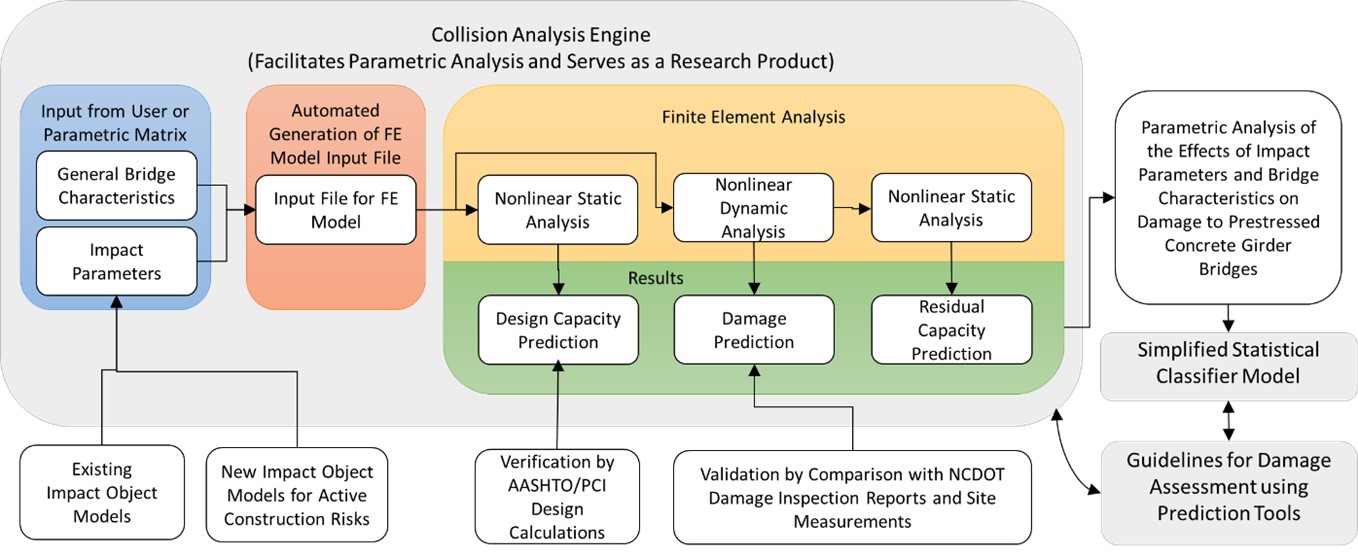The accidental collision of overheight construction equipment and vehicles with bridges under active construction presents engineers in the NCDOT Structures Management Unit with the challenging task of having to assess the effect of the collision on the strength and durability of the bridge. Furthermore, NCDOT must determine whether to accept repair or require replacement of the affected bridge girders while considering the near and long-term risks of acceptance, effect on project timeline and cost, and potential for litigation by the responsible party. When an overheight impact occurs on a bridge, bridge inspectors perform a damage inspection to document visible evidence of damage. Such inspections and the subsequent assessments of the effect of the damage on the strength and durability of the structure can be performed with greater confidence on structural steel and conventional reinforced concrete bridges than on prestressed concrete girder bridges, where the strength is developed through internal prestressing and significant damage caused by impact forces may not be visually apparent. Prestressed concrete construction is the predominant design for new bridges and accounts for a significant portion of the existing bridge inventory, including a sizeable number of older bridges with vertical underclearance below those specified in current NCDOT Bridge Policy.

Overview
of proposed research approach
The proposed project will leverage already verified and validated high-fidelity finite element models developed in the existing literature to comprehensively study damage mechanisms as well as expected reductions in capacity resulting from overheight collisions on prestressed concrete girder bridges. Furthermore, these models will be extended to introduce much needed capabilities for simulating impacts from objects most likely to collide with bridge girders during active construction, including excavators and dump trucks with raised beds. The extended models and methodologies will be validated primarily through comparison with case-studies sourced from NCDOT damage inspection reports. Additionally, enhanced validation using nondestructive evaluation of three bridges will be performed to ensure accurate prediction of both observable damage as well as internal damage and loss of prestress. Large-scale parametric analysis will be performed with the finite element models to develop a fundamental understanding of the effect that impacting object, location, and intensity as well as bridge characteristics have on nature, location, and severity of damage resulting from overheight collisions. Importantly, the research will also investigate the effect of these factors on the reduction in girder capacities to more directly inform do-nothing/repair/replace decisions.
The research will produce three significant, practice-oriented tools that will improve NCDOT's response to overheight collisions at both active construction sites and in-service bridges, mitigate safety risks associated with continued use or repair of damage girders, avoid unnecessary delays, and address potential litigation. These tools include a series of simple and quick-to-use decision trees to enable engineers to predict the nature, location, and severity of damage from overheight collisions. These decision trees will be statistically developed from the parametric analysis conducted in the research and will enable NCDOT to make timely, risk-informed decisions on bridge closures following impacts without requiring detailed analysis. In addition to the decision trees, the research will prepare the Collision Analysis Engine to be compatible with commercial finite element analysis software used by NCDOT to allow for detailed site-specific prediction of both the damage and resulting reductions in girder capacities following overheight collisions. The third research product will be a concise practitioner guide to assist NCDOT engineers in utilizing the developed analysis tools to rapidly assess impact-damaged prestressed concrete girder bridges and use the results to inform the scope and focus of damage inspections.
